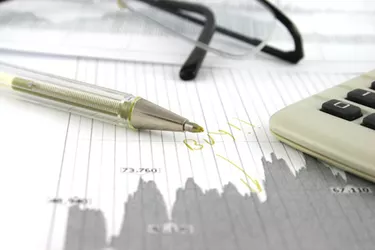
Many financial advisors recommend putting money behind the overall upward trajectory of the stock market, and a straightforward way is for your investments to reflect a popular and credible index like the S&P 500. Rather than investing in all the S&P 500 companies individually, you can invest in a fund that automatically tracks the index to reap the benefits of investing in America's top companies.
Understanding the S&P 500 List
Video of the Day
The S&P 500 list is an index put together by Standard and Poor's; the Corporate Finance Institute explains that Standard and Poor's is part of S&P Global, a leader in financial market analysis that produces benchmark indices and credit ratings for countries and businesses.
Video of the Day
The S&P 500 index is significant because it was the first index to be published daily and was launched in 1957. It tracks 500 large-cap publicly traded U.S. companies, weighted by their size. The S&P 500 companies are seen as a reasonably accurate representation of the overall health of the stock market or even the entire U.S. economy. The writers at Forbes note that when you hear reporters and financial experts talking about "the stock market," they are likely talking about the S&P 500 index.
Insofar as an index can be said to be traded, the S&P 500 is widely agreed to be among the best indexes to trade. In reality, you can't "buy or sell the S&P 500." While you could invest in each of the S&P 500 companies in the corresponding amounts, the straightforward way for your portfolio to reflect the S&P 500 is to invest in a mutual fund or exchange-traded fund (ETF) that tracks the index.
What Are ETFs?
The team at the CFI explains how ETFs work. Key takeaways are that mutual funds and ETFs let you "trade" an index like the S&P 500 in an indirect way just as if they were normal shares on the secondary market.
Still, the convenience of having the index packaged for you (as opposed to doing all the direct investing, tracking and weighing yourself) comes at a price in the form of the fund's expense ratio. TIME Magazine's NextAdvisor explains that mutual funds and ETFs that track the S&P 500 are an excellent way to partake in the overall profits of the stock market and quickly and easily diversify your portfolio.
Calculating Return on S&P 500 Investments
When calculating your actual returns from investing in the S&P 500, you need to calculate the index's change in value and the corresponding annualized rate of return. In addition, you also need to account for the fund's expense ratio, taxes due in the year of the sale and inflation in the intervening years. This is particularly true when, as is widely advised, you buy and hold for multiple years.
Throughout this example, fictitious numbers will be used to make the math more straightforward. Actual historical data on the S&P 500 is available on any reputable finance site such as Yahoo! Finance or Wall Street Journal. In addition, historical Consumer Price Index data is available from the U.S. Bureau of Labor Statistics CPI page, and the IRS has a page on the capital gains tax.
Example of S&P 500 Return Calculation
Assume that between January 2000 and January 2020, you invested in a fund that tracked the S&P 500. First, find the gross rate of return by subtracting the initial value from the final value and dividing the resulting number by the initial value. Finally, multiply by 100 to obtain a percentage. If the value in January 2000 was $1,400 and $3,800 at the start of 2020, then the gross rate of return over those 20 years was: ((3300 - 1400) / 1400) * 100 percent = (1900 / 1400) * 100 percent = 135.7 percent.
Next, obtain the annualized rate, which is the average yearly return over the period. Divide the gross return rate by the number of years: 135.7 percent/ 20 = 6.76 percent, corresponding to a gain of $67.60 per year.
Example of Expense Ratio
Now you need to account for the fund's expense ratio. If the fund has an 0.30 percent expense ratio, then you would divide that by the annualized rate: 0.30/6.76 = 0.0444. Subtract that from one and multiply by your dollar return: $67.60 * (1 - 0.0444) = $67.60 * 0.9556 = $64.60. Multiply by the length of time to get the total return after fund expenses: $64.60 * 20 = $1,292.
When you sell the shares in 2020, you are subject to the capital gains tax for that year, which you can assume to be 15 percent for the sake of this example, meaning you retain 85 percent. Calculating, $1,292 * 85 percent = $1,098.20. The after-tax rate works out to be 109.8 percent over 20 years. Finally, adjust for inflation. You can use an inflation calculator or assume an average rate. Assuming a 2 percent inflation rate every year, your adjusted profit would be $739.06.
Alternatively, there are S&P return calculators that use real historical data and adjust for inflation and reinvesting dividends. Don't enter personal information on an S&P investment calculator that is not on a reputable site.
Consider also: Differences in the S&P 500 and the Fortune 500